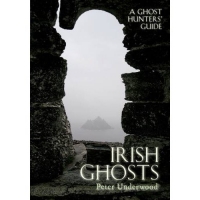The Packman and the Well
George Eakin had decided to clear away the ‘Cherry Tree Well’. It was a hazard to people and animals and, so far as George was concerned, a nuisance in the centre of a large and productive field some thousand yards from the home farm.
The well had served its purpose in its time of course, a time when it was surrounded by four small fields and there was no piped mains water for the livestock. George could clearly remember how, as a small boy, he would go with his grandfather, sometimes twice a day in dry weather, to pump water from the well to the adjacent cattle troughs in each of the adjoining fields. He would do no pumping however – his grandfather, or possibly his great-grandfather, had fitted a hand pump which was hard work for an adult never mind a child. His grandfather just seemed pleased to have him nearby. George would pick berries when in season and attempt to climb the nearby cherry tree while his grandfather laboriously supplied water to the ever-thirsty cows. The cherry tree was gone, the victim of age and weather, and the hedges and ditches had been cleared by George’s father at a time when the protection of bird’s nests and small animals was of less concern than the need to manoeuvre a large combine harvester.
The well itself, uncovered but for a rusting metal grille at ground level, was surrounded by an ancient hedge of knarled and twisted hawthorn, intertwined with generations of barbed wire and other objects put there in an attempt to impede the entrance of livestock. The old pump had long since gone, probably now someone’s garden ornament, and the little metal gate was overgrown and fixed with an enormous chain and ancient rusty padlock.
George did not like going to the well after his grandfather died, in fact as soon as the mains water was available to the cattle his grandfather also never went near it again. He said ‘there was something there’. When pressed he would only say that as he worked the pump he would get the impression of someone walking past, only to find that he was alone. This would happen two or three times during the hour or so it took to fill the water troughs.
George, with his farm hand driving the JCB, soon cleared away the hedge and lowered the immediate area around the well to over two feet from the surface to avoid any future hazard during cultivation. They covered the welltop with some of the large sandstone flags which had been used as paving around it, supporting these with pieces of old railway line cut to length. George was taking no chances that any of his expensive machinery would fall in. They finished it off by levelling out the surface with the addition of some topsoil to give the grass-seed a good start. By four-thirty and in good time for evening milking the only sign of the ‘Cherry Tree Well’ was a twenty foot circle of nicely harrowed soil.
Next day after the morning milking George returned to the farmhouse for his breakfast to be met by the comment from his wife, “I thought you said you had finished at the ‘Cherry Tree Well’. When asked what she meant his wife suggested he should go upstairs and look out the landing window. This he did and even at that distance could see that the well was not as he had left it the evening before. Forgetting his breakfast he hurried up the field, suspecting some game by his neighbours. He could hardly believe what he saw. The soil which had been used to cover the well was scattered all around, and the flagstones and metal rails were some twenty feet away. Try as he might he could see no sign of footprints or vehicle tracks, no evidence of the work needed to shift such an amount of material. Who would have perpetrated such an elaborate joke?
Immediately after breakfast he began the laborious task of replacing everything and by mid-afternoon the soil was harrowed level and ready for the grass-seed.
Next morning as soon as it was daylight he looked out towards the well, expecting to see it as he had left it. Surely no one would go to such enormous lengths twice. They had! He ran up the field to find the same scene as the morning before. George was irate. All that work for nothing! He considered calling the police but was unsure how his story would be received. How would he explain the lack of evidence, the absence of noise – the only access was through his farmyard – or the possible reason for such an act? In desperation he phoned his NFU agent, he had a mind to claim some of the cost from his insurance, to be met by the perfectly logical suggestion that a build up of gas might have forced the well open again. George was sceptical, especially as the agent informed him that there would be a charge to have the relevant authorities check for such a phenomenon.
After breakfast George decided he would carry out his own investigation, rather foolishly perhaps if the cause was gas. He took a ladder – he had noted that the water level was less than six feet from ground level – and lowered it carefully into the well. After working it around some impedance, possibly rubble that had fallen in he thought, the ladder seemed securely settled on the well bottom. There was actually less that three feet of water. George gingerly descended the ladder holding a small torch. There was a slight musty smell but no indication of what George imagined a explosive gas might be like. There was no damage to the well lining, it was stones and mortar and apart from some moss and lichen was unmarked.
He shone the torch into the water which as it settled revealed what appeared to be a box approximately the size and shape of a medium suitcase. He carefully leant down to work one hand under the box in an attempt to lift it. George almost fell off the ladder in surprise! The box was attached in some way to what appeared to be a rib-cage, human or animal he could not tell, but definitely part of a skeleton. As the water began to clear again he realised that what he had thought was a stone was in fact a skull, very obviously human. He dropped his torch in his haste to get up the ladder and away from the well!
After a day of careful searching the police forensic team recovered a complete human skeleton – and a wooden box with the remains of a leather harness by which it would seem to have been carried in the manner of a primitive back-pack. It was found to contain various bits and pieces such as needles, spools of what had been sewing thread, tobacco tins, and other small items found in the average household. There was also a small amount of cash in coinage issued in the reign of Edward VII and George V. The most interesting items were the remains of what turned out to be Campaign Medals relating to British Army activities in Afghanistan towards the end of the 19th Century. The name on one read “4782 Colour Sergeant J.M. Miller, 72nd Foot”.
The subsequent inquiry found that the skeleton was that of an elderly male, possibly in his seventies, with evidence of old injuries and arthritis and other probably painful joint deformities. Cause or time of death could not be determined and only an open verdict was possible. Identification was conjecture based on hearsay by some of the older residents of the area as the coroner would not accept the medal as evidence.
The back-pack was in fact very solid evidence, particularly as it was actually harnessed to the body when found and had the letters JM roughly engraved inside the lid. In the generations preceding our very affluent society it was quite common to have a travelling ‘pack-man’ visit country homes on a regular basis. He would carry a selection of essential household and personal items for the housewife and her family to inspect and buy as they choose. Most of these pack-men appeared to be elderly or infirm, often old soldiers down on their luck, who eked out a living in this manner rather than beg or ask for state assistance. They would of course receive the normal hospitality of the countryside of their time and could depend on tea and scones, sometimes a full meal, in virtually every home they visited. The children were generally in awe of them and indeed local superstitions in many areas ensured their safe passage.
Johnny Miller was one such pack-man. He was known to be an ex-soldier although he never discussed his personal life with anyone. He would call at the same homes on the same day every month. His catch-phrase was ‘all colours of black-thread’. He had no known family and lived in what was actually a small outhouse or shed belonging to a local farmer. He paid no rent and was never asked for any.
Although usually seen on public roads he would often walk through farmland to shorten his journey. No one ever suggested he was trespassing. One of his walks took him from the Eakin farm to the Burns farm just over the hill, the most direct route being by the ‘Cherry Tree Well’.
Johnny Miller stopped calling. People wondered, and some were concerned enough to ask the police to check. However apart from a visit to his small home, which was found to be very neat and tidy although it contained nothing of worth, and some general enquiries, no intensive investigation was undertaken. He was an adult, with no family to concern themselves, and was legally entitled to go his own way.
The remains were eventually given a Christian burial in the local cemetery, the register being marked ‘unknown’, although the surprisingly large number of local people who attended were convinced he was an old soldier called Johnny Miller. Few of those present would even have heard of him, possibly their parents or grandparents would have met him or heard their parents refer to him, but they felt he deserved to be acknowledged.
George Eakin never covered the well again. He replaced the hedge and gate, rebuilt the well to its original height, and fitted a safety grill over it. He also planted a cherry tree alongside. It is now known as ‘Johnny Miller’s Well’.
Since that time no one has ever reported evidence of any presence there. Perhaps the packman has made his last visit
By James Henderson




Recent Comments